Answers to Common Door Hardware Questions
Why is Door Thickness Important?
Handleset and Deadbolt Functions?
| When you’re choosing the latch for your new door, you will need to know the backset |
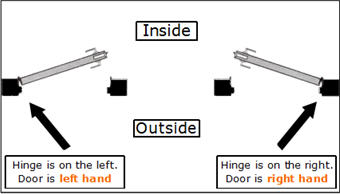 | Some lever sets require you to determine whether the door is a Right-Hand or Left-Hand Door.
|
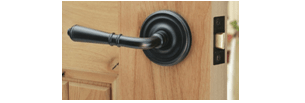 | Most interior doors measure 1 3/8” thick, while most exterior doors measure 1 3/4” thick. What if your door is thicker or thinner that these standard measurements? Don’t worry, you’ll just need additional components to connect the hardware from one side of the door to the other. Please contact customer service to determine which components you will need for your particular door. |
 | Passage Sets - Passage or Hall and Closet Door Knobs/Levers are used on doors that do not require a locking mechanism. Halls, closets, pantry or laundry doors will generally use a passage set. Passage door sets do not have a locking mechanism. |
 | Privacy Sets are most often used on Bedrooms, Baths or Office doors where a lock for privacy while occupied is desired, but a keyed lock is not really necessary. Privacy knobs/levers have a turn button or push button to activate the lock. On the outside, there is a pin hole for emergency unlocking. |
 | Keyed Entry Sets are generally used on exterior doors, but sometimes used on interior doors where security is a concern. Keyed entrance sets have a push pin or turn lock on the inside, similar to a privacy lock. On the outside there is a keyed cylinder. If the knob/lever is locked from the inside a key is required for entrance. |
 | Single Dummy knobs or levers are sold individually and do not have a latch mechanism of any kind. They are surface mounted to a door that has not been bored (no hole has been cut into the door). They are generally used on doors that use a ball catch or magnet at the top of the door to keep them closed. They are also commonly used on double doors/French doors to match the active door trim. |
 | Dummy Pairs (Full Dummy) – are sold in pairs and do not have a latch mechanism of any kind. They are generally surface mounted to a door that has not been bored (no hole has been cut into the door). They are generally used on doors that use a ball catch or magnet at the top of the door to keep them closed. They are also commonly used on double doors/French doors to match the active door trim. |
Handleset & Deadbolt Functions
 | Single Cylinder – locked and unlocked by a key from the outside and a thumb turn on the inside. |
 | Double Cylinder - locked and unlocked by a key from the outside and the inside. |
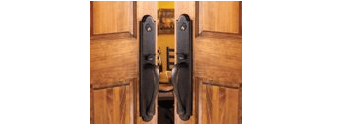 | Dummy Handleset - If you have a double front door where one side is generally inactive while the other is always active, you will need a combination of two handle sets. For the active side, you'll need a single or double cylinder Handleset. For the inactive door, you'll want to order a dummy Handleset. This gives you the look of a complete working set, but doesn't have all of the mechanisms - perfect for an inactive door. |
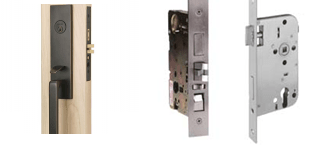 | A mortise style lock requires a special cut in the door that allows a longer and thicker mortise to slide into the pocket in the door itself, providing superior protection. These types of locks require special door preparation, so if your door isn’t currently cut to fit this kind of lock, you (or a professional installer) will need to use a mortise saw to cut into the door so the lock fits properly. Take note that not all mortise locks have the same dimensions. So prior to any door alteration, take careful measurements. This kind of lock was commonly seen in homes prior to 1940 (before the introduction of bored cylindrical locks), but is still available today in single cylinder, double cylinder, and dummy sets. |
 | If you are buying more than one lock you will need to decide if you want your locks to be keyed alike (all using the same key) or keyed differently (all using a different key). Be aware that keying is not the same across manufacturers – if you order two different locks from two different manufacturers, the keys will probably not match. Please call customer service if you are ordering from more than one manufacturer and would like your locks keyed the same. We can also Custom Key your locks – so if you wish to replace existing hardware with the same manufacturer and use the same key, we are able to do this for you. All we will need is the key number, (usually stamped on the key, 5 digits) or you can mail a copy of your key to our licensed warehouse. When ordering from LowPriceDoorKnobs.com, we will send you two keys for each lock that you have keyed differently. For locks keyed alike, you will receive 4 keys for 2 locks keyed alike, 5 keys for 3 locks keyed alike and 6 keys for 4 or more locks keyed alike. |
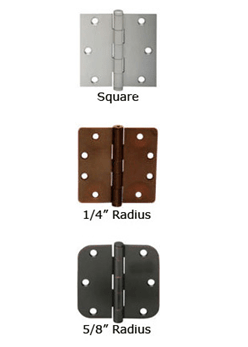 | To order door hinges, you will first need to determine the corner type – Square or radius? If the corners are radius you will need to confirm if they are either 5/8” or ¼”. A 1/4” radius hinge has less of a curve that a 5/8” radius hinge. An easy way to check, is to hold us a quarter to the corner of the hinge. If the quarter is a close fit then you have 5/8” radius hinges. Hint: The top of a pencil will fit into the corner of ¼” radius hinges.
|


